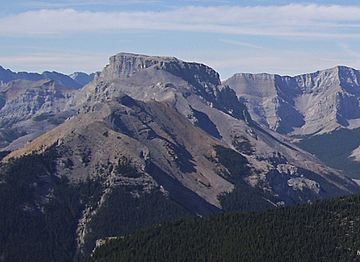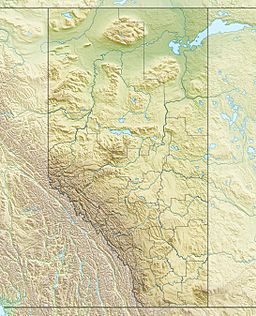Mount Remus facts for kids
Quick facts for kids Mount Remus |
|
|---|---|

Mount Remus seen from Nihahi Ridge
|
|
| Highest point | |
| Elevation | 2,688 m (8,819 ft) |
| Prominence | 341 m (1,119 ft) |
| Parent peak | Mount Romulus (2832 m) |
| Listing | Mountains of Alberta |
| Geography | |
| Location | Elbow-Sheep Wildland Park Alberta, Canada |
| Parent range | Fisher Range Canadian Rockies |
| Topo map | NTS 82J/15 |
| Climbing | |
| Easiest route | Scrambling |
Mount Remus is a tall mountain peak, or summit, found in the Little Elbow River Valley. It stands 2,688-metre (8,819-foot) high in Kananaskis Country, which is part of the Canadian Rockies in Alberta, Canada.
This mountain is named after Remus, a famous character from ancient Roman stories. Remus and his twin brother, Romulus, are known as the mythological founders of Ancient Rome. The name "Mount Remus" was officially recognized in 1940. Mount Remus is quite close to its taller neighbor, Mount Romulus, which is about 2.0 km (1.2 mi) to the west-southwest.
What is Mount Remus Made Of?
Mount Remus is made up of sedimentary rock. This type of rock forms from layers of sand, mud, and tiny bits of plants and animals that settle over time. These layers were laid down during very old periods of Earth's history, from the Precambrian to the Jurassic times.
These rocks were formed in shallow seas long ago. Later, during an event called the Laramide orogeny, powerful forces pushed these rock layers eastward. This movement caused them to fold and stack on top of younger rocks, creating the mountains we see today.
Mount Remus's Climate
Mount Remus has a subarctic climate. This means it experiences very cold and snowy winters. Summers are usually mild, not too hot. Temperatures can drop below −20 °C. With the wind chill factor, it can feel even colder, sometimes below −30 °C.
If you want to visit, the best time for good weather is from June through September. Water from rain and melting snow on the mountain flows into the Little Elbow River. This river then joins the Elbow River, acting as a smaller stream that feeds into a larger one.



